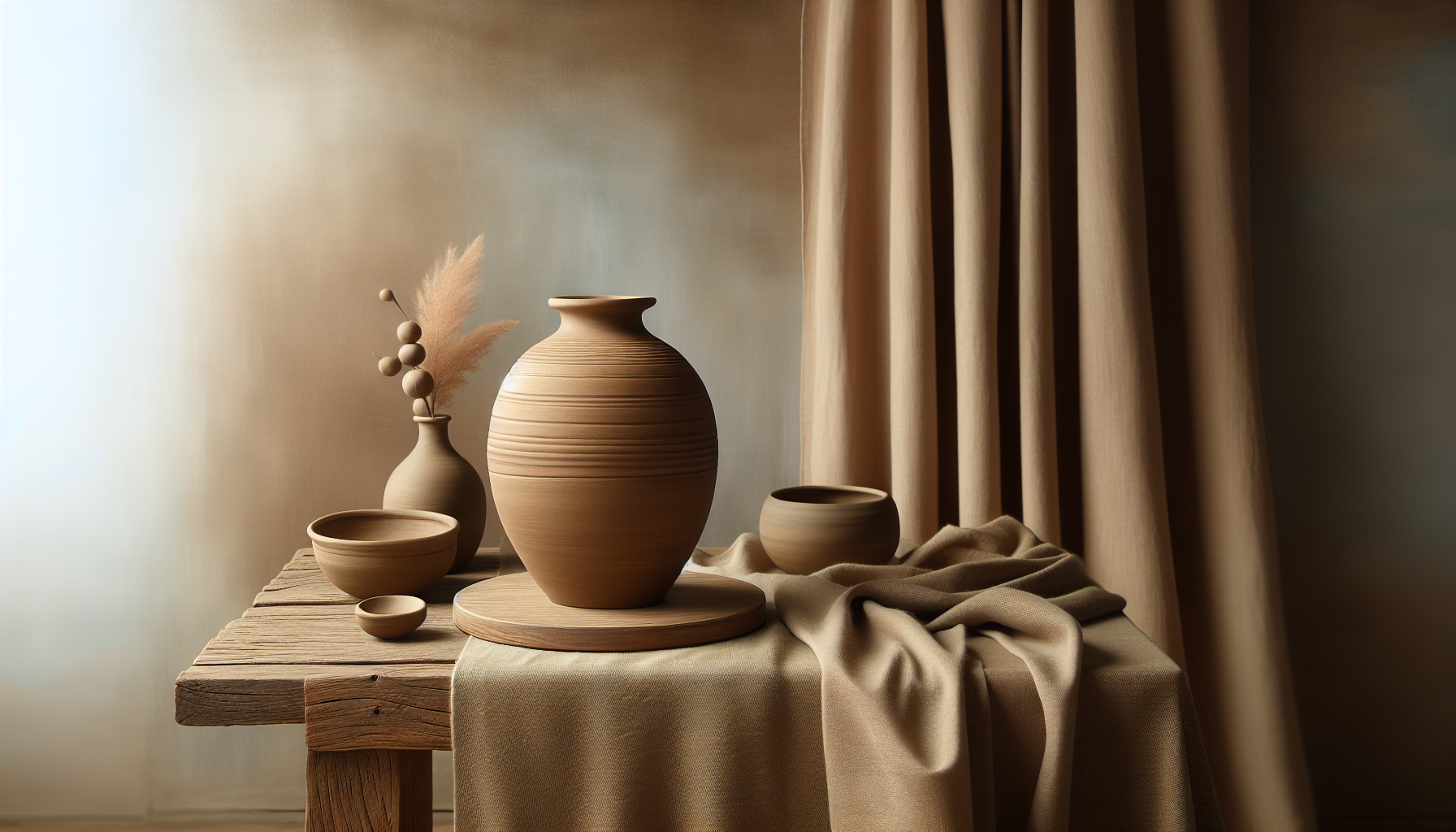What if you could create a space that blends serene simplicity with warm, earthy tones?
Japandi style might just be the solution you’re looking for. With its harmonious blend of Japanese minimalism and Scandinavian functionality, this design aesthetic emphasizes both beauty and practicality. Adding terracotta tones into the mix can transform your space into a cozy sanctuary that feels inviting and tranquil. In this guide, let’s explore how you can incorporate terracotta hues into your Japandi-inspired home.
Understanding Japandi Style
At its core, Japandi style merges the best of two worlds: the simplicity and elegance found in Japanese design and the warmth and functionality typical of Scandinavian interiors.
Key Characteristics of Japandi Style
- Minimalism: Emphasizing a “less is more” philosophy, Japandi design avoids clutter and distractions, creating a calm environment.
- Natural Materials: Wood, bamboo, and textiles made from natural fibers are integral to achieving the Japandi look.
- Neutral Palette: Soft, muted colors dominate the palette, creating a serene atmosphere conducive to relaxation.
- Functionality: Every element has a purpose, balancing form and function beautifully.
By understanding these key elements, you can begin to see how terracotta tones fit beautifully within this aesthetic.
The Allure of Terracotta Tones
Terracotta, with its rich earthy hues, brings a sense of warmth and comfort to any space.
What are Terracotta Tones?
Terracotta tones refer to the warm, earthy colors reminiscent of baked clay. These include shades of orange, red, and brown—all of which provide a cozy, grounding aspect to interiors.
- Warmth: Terracotta hues add a unique warmth, softening the minimalist rigidity of a strictly neutral palette.
- Texture: The rustic quality of terracotta can add depth and character to more modern pieces.
Why Use Terracotta in Japandi Design?
Incorporating terracotta into Japandi design marries excellent style elements. The earthy tones complement natural materials and add a welcoming appeal, transforming your space into a cozy retreat.
Incorporating Terracotta into Japandi Style
So, how can you seamlessly weave terracotta tones into your Japandi-inspired home? Here are some practical tips to get you started.
Color Combinations
Combining terracotta shades with the traditional Japandi color palette can create harmonious and visually impactful rooms.
| Terracotta Shades | Complementary Colors |
|---|---|
| Rich terracotta orange | Soft beige, pale gray |
| Deep rusty red | Cream, off-white |
| Subtle terracotta brown | Soft green, dusty blue |
Artwork and Decor
Artwork and decor items can be a great way to introduce terracotta while maintaining your Japandi ethos.
- Wall Art: Look for pieces that incorporate terracotta shades. Artwork with simple lines or abstract forms can uphold the minimalist principle.
- Ceramic Pieces: Terracotta pottery or vases can serve as beautiful centerpieces, drawing attention without overwhelming the space.
Furniture Selection
When selecting furniture, consider options that harmonize with the Earthy tones of terracotta.
- Wooden Furniture: Opt for light wood finishes that contrast softly with darker terracotta.
- Low-Profile Designs: Choose furniture with low, clean lines typical of Japandi aesthetics, which promote ease and simplicity.
Textiles and Fabrics
The use of textiles is an effective way to integrate terracotta without overwhelming the overall design.
- Cushions and Throws: Soft terracotta-colored throws or cushions can add warmth to a light sofa, inviting comfort and relaxation.
- Rugs: A low-pile rug in a subtle terracotta shade can bring warmth to wood or tile flooring while keeping the overall look grounded.
Plants and Natural Elements
Incorporating greenery with your terracotta tones enhances the natural warmth and refreshes your space.
- Terracotta Planters: Use terracotta pots for your indoor plants; they offer a perfect aesthetic balance.
- Natural Materials: Accentuate your terracotta with other natural elements like jute, linen, and clay to maintain that earthy, organic feel.
Lighting Solutions
Lighting plays a crucial role in enhancing your color palette.
- Warm Light Sources: Use warm-toned bulbs to highlight the terracotta tones in your space. Light fixtures in brass or natural materials can also complement this aesthetic beautifully.
- Simple Designs: Consider minimalistic lamps that echo Japandi principles while allowing terracotta to be the star.
Creating a Japandi Terracotta Space
Now that you have a few ideas, let’s bring it all together to create a stunning Japandi space enriched with terracotta tones.
Step 1: Choose Your Base Colors
Start by selecting a neutral base for your walls and large furniture pieces. Soft whites, light grays, or even beige can provide a calm backdrop for the warmth of terracotta.
Step 2: Introduce Terracotta Accents
Add terracotta details in small doses. This can include decorative items, wall art, or a rug. Choose one or two key pieces to make a statement without overwhelming the space.
Step 3: Layer with Textures
Layer different textures through textiles and natural materials to add depth. Mix and match soft fabrics with hard surfaces like wood and terracotta.
Step 4: Add Greenery
Incorporate plants in terracotta pots to bring a touch of nature indoors—opt for greenery that thrives in your specific indoor environment.
Step 5: Final Touches
Finish off your space with thoughtful lighting and accessories that enhance the terracotta tones while maintaining the Japandi minimalist appeal.
Maintenance Tips for a Japandi Terracotta Home
Maintaining your Japandi style can be relatively straightforward if you stay consistent with your theme and keep a few essential tips in mind.
Dust and Clean Regularly
- Natural Materials: Use a soft, dry cloth to clean wooden furniture and terracotta. Avoid harsh chemicals to maintain the integrity of the materials.
- Textiles: Regularly wash fabrics according to the care instructions to keep them fresh and vibrant.
Seasonal Refreshes
Changing accents according to seasons can keep your space lively and vibrant:
- In winter, opt for deeper terracotta tones along with chunky knitted throws.
- In summer, lean into lighter textiles paired with fresh green plants for a refreshing look.
Monitor Plant Care
- Watering Schedule: Ensure that your indoor plants receive appropriate care according to their needs, especially if they’re housed in terracotta pots, which are porous and may require more frequent watering.
Inspiring Japandi Terracotta Rooms
Imagining your space can be a great way to visualize how everything fits together. Here are some ideas for specific rooms:
Living Room
In the living room, a large terracotta vase on a wooden coffee table can become a conversation starter. Layer a muted terracotta rug beneath a minimalist couch, topped with cushions in soft creams or grays.
Bedroom
For the bedroom, paint the walls a soft beige and use terracotta bedding to create a warm cocoon. Incorporate light wood furniture and small potted plants on window sills, maintaining that earthy, welcoming vibe.
Kitchen
In the kitchen, terracotta can come in the form of pots and pans or wall art featuring earthy tones. A well-placed terracotta dish can create an inviting display atop open shelves.
Final Thoughts
Incorporating terracotta tones into your Japandi style home is an exciting opportunity to blend colors and textures that create warmth and tranquility. By thoughtfully selecting decorative elements, furniture, and colors, you can cultivate an inviting atmosphere that reflects both your personality and the serene, functional essence of Japandi design.
The alluring synergy between terracotta tones and the simplicity of Japandi design invites you to create a space that welcomes you and your guests, offering both comfort and beauty. Whether you start small or make changes throughout your home, exploring this unique combination can lead to a space that truly feels like home. As you embark on this decorating journey, remember that each piece and color choice reflects your vision—bringing comfort, style, and joy into your daily life.

